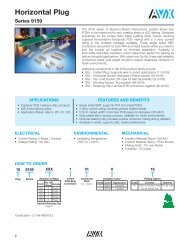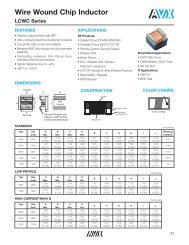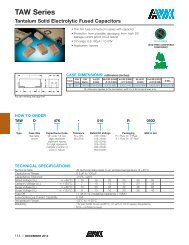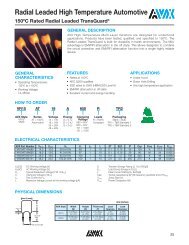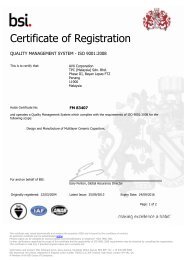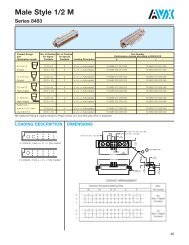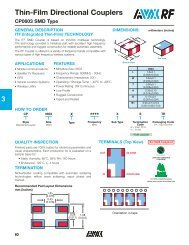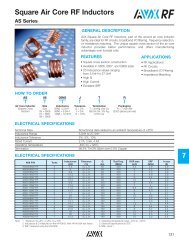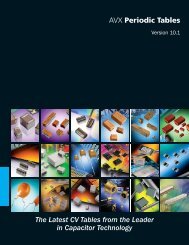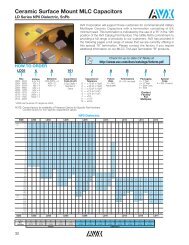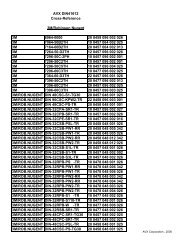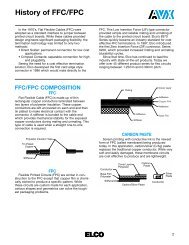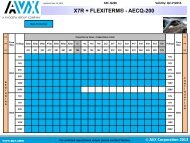X5R Dielectric LD Series Tin/Lead Terminations - AVX
X5R Dielectric LD Series Tin/Lead Terminations - AVX
X5R Dielectric LD Series Tin/Lead Terminations - AVX
You also want an ePaper? Increase the reach of your titles
YUMPU automatically turns print PDFs into web optimized ePapers that Google loves.
Tip & Ring <strong>Tin</strong>/<strong>Lead</strong> Termination “B”<br />
Multilayer Ceramic Chip Capacitors<br />
<strong>AVX</strong> Corporation will support customers for commercial and military Multilayer<br />
Ceramic Capacitors with a termination consisting of 5% minimum lead. This<br />
termination is indicated by the use of a “B” in the 12th position of the <strong>AVX</strong> Catalog<br />
Part Number. This fulfills <strong>AVX</strong>’s commitment to providing a full range of products to<br />
our customers.<br />
<strong>AVX</strong> “Tip & Ring” or “ring detector” Multilayer Ceramic Chip Capacitors are<br />
designed as a standard telecom filter to block -48 Volts DC telephone line voltage<br />
and pass subscriber’s AC signal pulse (16 to 25Hz, 70 to 90 VRMS). The ringer<br />
capacitors replace large leaded film capacitors and are ideal for telecom/modem<br />
applications. Using <strong>AVX</strong> “Tip and Ring” capacitors not only saves valuable real<br />
estate on the board and reduces the weight of the overall product, but also features<br />
standard surface mounting capabilities, so critical to new and compact designs.<br />
The <strong>AVX</strong> “Tip & Ring” capacitors are offered in standard EIA sizes and<br />
standard values. They offer excellent high frequency performance, low ESR<br />
and improved temperature performance over film capacitors.<br />
Check for up-to-date CV Tables at<br />
http://www.avx.com/docs/catalogs/apt&rb.pdf<br />
HOW TO ORDER<br />
<strong>LD</strong>12 P<br />
C<br />
104<br />
K<br />
A<br />
B<br />
1<br />
A<br />
<strong>AVX</strong><br />
Style<br />
<strong>LD</strong>05 - 0805<br />
<strong>LD</strong>06 - 1206<br />
<strong>LD</strong>10 - 1210<br />
<strong>LD</strong>08 - 1808<br />
<strong>LD</strong>12 - 1812<br />
<strong>LD</strong>13 - 1825<br />
<strong>LD</strong>20 - 2220<br />
<strong>LD</strong>14 - 2225<br />
Voltage<br />
250 VDC<br />
Telco<br />
Rating<br />
Temperature<br />
Coefficient<br />
X7R<br />
Capacitance Code<br />
(2 significant digits<br />
+ no. of zeros)<br />
Examples:<br />
1,000 pF = 102<br />
22,000 pF = 223<br />
220,000 pF = 224<br />
1 μF = 105<br />
Capacitance<br />
Tolerance<br />
K = ±10%<br />
M = ±20%<br />
Test Level<br />
A = Standard<br />
Termination<br />
B = 5% Min Pb<br />
X = FLEXITERM ®<br />
5% min. Pb<br />
Packaging<br />
1 = 7" Reel<br />
3 = 13" Reel<br />
9 = Bulk<br />
Special Code<br />
A = Standard<br />
Contact factory for availability of Termination and Tolerance options for Specific Part Numbers.<br />
Not RoHS Compliant<br />
PERFORMANCE CHARACTERISTICS<br />
Capacitance Range 1000 pF to 1.2 μF (25°C, 1.0 ±0.2 Vrms at 1kHz)<br />
Capacitance Tolerances ±10%, ±20%<br />
Dissipation Factor<br />
2.5% max. (25°C, 1.0 ±0.2 Vrms at 1kHz)<br />
Operating Temperature Range<br />
-55°C to +125°C<br />
Temperature Characteristic<br />
X7R ±15% (0 VDC)<br />
Voltage Rating<br />
250 VDC Telco rating<br />
Insulation Resistance<br />
1000 megohm-microfarad min.<br />
<strong>Dielectric</strong> Strength<br />
Minimum 200% rated voltage for 5 seconds at 50 mA max. current<br />
CAPACITANCE RANGE (μF)<br />
STYLE (SIZE) <strong>LD</strong>05 (0805) <strong>LD</strong>06 (1206) <strong>LD</strong>10 (1210) <strong>LD</strong>08 (1808) <strong>LD</strong>12 (1812) <strong>LD</strong>13 (1825) <strong>LD</strong>20 (2220) <strong>LD</strong>14 (2225)<br />
min. 0.0010 0.0010 0.0010 0.010 0.10 0.33 0.47 0.47<br />
max. 0.027 0.082 0.22 0.27 0.47 1.0 1.0 1.2<br />
22 | www.avx.com



